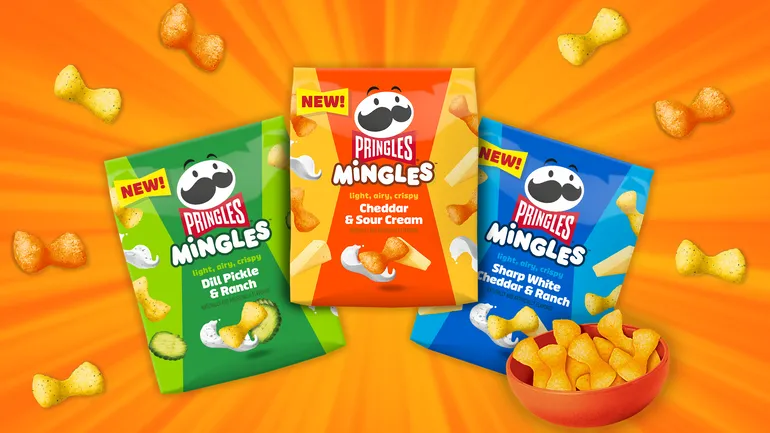Why Kellanova sees Pringles as its gateway to snacking domination

Kellanova made a big bet in 2022 to split off its cereal operations and focus its efforts on its snacking brands in order to compete with rivals like Mondelēz International and PepsiCo’s Frito-Lay. A key part of its aims is to boost the value of Pringles, its household staple of stackable curved potato chips, into a $4 billion brand.
In a conference with Wall Street investors last August, Steve Cahillane, the CEO of Kellanova, singled out Pringles as a brand in the company’s arsenal that has still yet to reach its full potential. The executive said the chips have vast potential for global domination, based on its ability to adapt to shifting trends in the marketplace through new product innovation.
Sarah Reinicke, Kellanova’s vice president of salty snacking marketing, said in an interview with Food Dive the brand is uniquely primed to help the company achieve growth given its wide appeal.
“This is a brand that’s a manufactured crisp, designed for precision in a can to beat all the breaking, greasy potato chips,” Reinicke said.
The secret weapon of Pringles, according to Reinicke, is the brand’s ability to replicate almost any flavor in an accurate way, from Carnitas Taco to Everything Bagel, making up its over 160 flavors worldwide. This helps the chip adapt to different cultures as it launches new varieties internationally.
“We can take all of these local flavors and just put them on a chip, like prawn in Asia, or Texas barbecue in the U.S.,” Reinicke said.
The company, under its previous name Kellogg, first acquired Pringles in 2012 for a hefty $2.7 billion, tripling the size of its snacks division. Pringles now generated $3 billion in annual revenue, Kellanova said at a Consumer Analyst Group of New York presentation earlier this year.
Kellanova has also been experimenting with new flavors and formats for the brand. over the past year. In May, the company announced Pringles Mingles, a puffed snack with a crispy exterior and light interior that comes in a bag, instead of its tall container. The snack is in the shape of a bowtie, modeled after its mascot Mr. P. Pringles Mingles will debut on shelves in October in three flavors: Cheddar & Sour Cream, Dill Pickle & Ranch and Sharp White Cheddar & Ranch.
“It’s a big deal to take Pringles out of the bag. We feel like it’s a huge lever for transformative growth for the brand,” Reinicke said. “We’re not leaving the can, but it gives us a new way to innovative a drive shareable moments of consumption as we build out the business.”

Pringles Harvest Blends, made with multigrains and sweet potato.
Courtesy of Kellogg
Innovating an iconic chip
Some of its innovation has remained within its traditional chip style. Last year, the company launched Pringles Harvest Blends, made with blended multigrain and sweet potato ingredients, targeting consumers looking for a healthier alternative to traditional potato chips.
Kellanova is hoping its innovation gamble is starting to pay off. In its most recent quarter, the company’s organic sales rose 5.4% from the same period a year prior, driven in part by raising prices by 4.8%.
The Pringles R&D pipeline is driven by a desire to boost sensory experiences and experiment with new ways to reinvent the traditional chip.
A boon to the brand in recent years is its spicy offerings, according to Reinicke. In 2020, the brand launched Pringles Scorchin’, its first dedicated collection of hotter varieties. Spicy snacks across the board have seen a significant surge in recent years, fueled in large part by the growth of Frito-Lay’s Flamin’ Hot flavored snacks, which it established as its own brand earlier this year.
Pringles sees its flavors as a “global library,” Reinicke said, which can allow for cross-pollination based on different regions the company is selling its chips in. She gave the example of a Mexican Street Corn flavor, which was crafted downstream of trends the company was observing.
The company is confident the strength of the brand can help it withstand something consumers are increasingly worried about: high inflation on grocery shelves.
“We’re able to command the price that we need because of the strong consumer value that we can through our chip,” Reinicke said.
Source: fooddive.com

